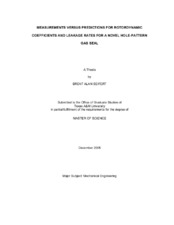| dc.description.abstract | Results are presented for measured and predicted rotordynamic coefficients and
leakage for hole-pattern seals with a hole depth that varies axially along the seal.
Testing was done to discover how pressure ratio, inlet preswirl, and rotor speed affect
the seals’ rotordynamic characteristics and leakage. The results were compared to a
constant hole depth hole-pattern seal.
Experimental results show that the seals’ rotordynamic characteristics are not
strongly influenced by pressure ratio.
There were three preswirl conditions tested, each separated by a 6.9 bar (100
psi) difference in inlet pressure. Therefore, normalized preswirl results were compared.
The normalized results indicate that introducing inlet fluid preswirl affects the crosscoupled
stiffness and effective damping coefficients. Inlet preswirl increases the
magnitude of cross-coupled stiffness. Effective damping decreases with inlet preswirl,
as well as the effective damping cross-over frequency increasing. These results
indicate that swirl brakes would be of great value.
Rotor speed had a significant effect on the cross-coupled coefficients; both
increased with speed.
Experimental results were compared to results for a constant hole depth holepattern
seal. The variable hole-depth seal has higher direct damping. The crosscoupled
stiffness and cross-coupled damping coefficients were very similar. The direct
stiffness was always lower at lower frequencies and higher at higher frequencies for the
variable hole depth hole-pattern seal. This was also the case for effective stiffness.
The effective damping of the variable hole-depth seal was not only larger than for the constant hole depth seal, it also had a drastically lower cross-over frequency. The
difference in cross-over frequency was 40 percent on average.
Experimental results for rotordynamic characteristics and leakage were
compared to theoretical predictions by ISOTSEAL 2, a modified version of ISOTSEAL.
Both cross-coupled stiffness and damping are reasonably predicted. Direct damping is
always under-predicted. ISOTSEAL 2 does a poor job of predicting direct stiffness.
Direct stiffness is over-predicted at lower frequencies and under-predicted at higher
frequencies. This is also the case for effective stiffness. ISOTSEAL 2 under-predicts
the direct damping, but does an excellent job of predicting the direct damping crossover
frequency. Seal leakage is well predicted by ISOTSEAL 2. | en |


